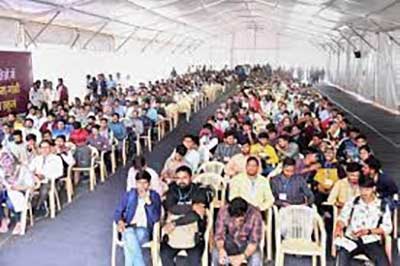Date: 01/12/2022
Relevance: GS-3: Indian Economy and issues relating to Planning, Mobilization of Resources, Growth, Development and Employment; Effects of Liberalization on the Economy, Changes in Industrial Policy and their Effects on Industrial Growth.
Key Phrases: Ageing Population, Economic Growth, Saving Rate, Global Secular Forces, Structural Strength, Global Driver, Youth Bulge, Panch-Pran, Infrastructure Development, Education and Health Sector Investment, Skill Development, Middle Class, Future Potential, Demographic Dividend.
Context:
- As global economic growth goes down well below 2 per cent in 2023, India’s economic growth is expected to remain at 5 per cent. It is a reflection of India’s structural strengths and growth drivers.
Key Highlights:
- For global growth a combination of transitory shocks and secular forces
has created a highly uncertain future, with the potential for a medium-term
global stagnation.
- But India is being viewed as a bright spot in this global downturn.
Responsible Factors for India’s Progress:
- World’s Ageing Population Issues
- Global population is getting older rapidly across the cohort of countries that make up more than 75 percent of global GDP fuelling pressure on wages, supply shocks, pandemics, and high debt levels associated with an aging population.
- Trade and finance policies are being used to cope not only with transitory shocks but also secular forces of ageing population and climate change.
- Less prone to the Changes in Global Secular Forces
- India is a success story on the export of services, and services tend to shrink less compared to manufacturing during global economic downturns.
- Global exports of digitally delivered services have more than tripled during the last two decades, far greater than trade in goods, and India stands out as a winner.
- India’s Youth Bulge
- India’s growth will continue to benefit from demographic dividend and youth bulge.
- India’s demographic profile is well positioned to withstand adverse macroeconomic shocks, and there is space to borrow from residents, and build public private partnerships to finance additional spending on physical and human infrastructure.
Future Potential Advantages for India:
- Lower Risks of Wage-price Spiraling Upwards
- India’s young population will avoid the risks of wage-price spiraling upwards, given the swelling of the labour force as baby boomers reach working age.
- Decline in Fertility
- It is expected that there will be a rise in women’s workforce activity that naturally accompanies a decline in fertility.
- Creation of Infrastructure and Technological Innovation
- Working ages also happen to be the prime years for savings, which is key to the accumulation of capital, creation of infrastructure and technological innovation.
- Boost to Saving Rate
- The further boost to savings that occurs as the incentive to save for longer periods of retirement increases with greater longevity.
Key Contributions of Middle Class:
- India is expected to emerge with a middle class that is proportionately
as large as that of the US today. There are four key contributions that the
middle class makes to economic growth and social progress-
- Source of Entrepreneurship
- A strong middle class fosters innovation and encourages entrepreneurs to start their own businesses, which in turn creates good jobs that support a growing economy and social progress.
- Major Contributor to Savings and Human Capital
- Savings rates and the willingness to invest in human capital are higher amongst middle class households.
- Strengthening the Links with Education
- They strengthen the links with democracy, free press, education and fair elections.
- Favorable Consumption Pattern
- The expanding demand for consumer durables—cars, motorcycles, televisions, air conditioners, mobile phones and refrigerators—is already leading to an acceleration in manufacturing in India.
- The middle class is also demanding housing, shopping malls, and other infrastructure, and can afford to take an annual vacation, boosting domestic tourism.
- Source of Entrepreneurship
Way Forward:
- Almost a billion people will join the ranks of the middle class by 2025, if India can expand investments in physical and human infrastructure, declare independence from the virus, spur rural vitalisation, and reduce inequality.
- The government is unlikely to be able to provide the quantity and
quality of services that will be demanded, even in areas like health,
education and water that have evolved as public-sector areas in other
countries.
- India will have to adopt hybrid systems, with private and public service providers.
- This can be achieved if India can push for an increase in lending by
global and regional multilateral institutions.
- There is a huge potential, for example, to push for a large issuance of Special Drawing Rights, the International Monetary Fund’s reserve asset.
Conclusion:
- There are many reasons to be optimistic about India’s future growth that will be driven by the rapidly rising middle class, young demographics and the next wave of globalisation.
- By increasing the rational investment in education, skill development and health, India has the potential to fulfill its dream of developed country status by 2047 (one of Panch-Pran given by the prime minister of our country).
Source: BusinessLine
Mains Question:
Q. What are the potential advantages of increasing middle class populations? Also, suggest associated challenges and the measures to address the challenges. (250 Words)








